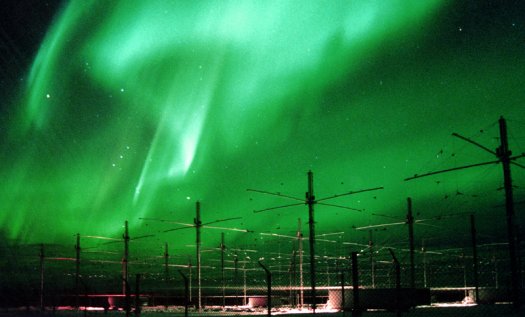Conspiracy theorists concerned with intentional weather modification will have to find someone else to blame, because HAARP (the High Frequency Active Auroral Research Program) has closed.
The 35-acre ionospheric research facility in remote Gakona, Alaska – 200 miles north of Anchorage – shut down in early May 2013. HAARP has an antenna array used by scientists to study the outer atmosphere by zapping it with radio waves generated by 3,600 kilowatts of electricity. Not sure how, but HAARP became infamous among conspiracy theorists and some environmental activists, who believed it was responsible for intentional weather modification. Dire events – such as Hurricane Sandy in late 2012 – have been blamed on HAARP by people called “uninformed” by scientists and other commentators. But no more. HAARP’s program manager, Dr James Keeney, said in a July 15, 2013 press release:
Currently the site is abandoned. It comes down to money. We don’t have any.
According to Keeney’s press release, the only bright spot on HAARP’s horizon right now is that the Defense Advanced Research Projects Agency (DARPA) is expected on site as a client to finish up some research in fall 2013 and winter 2014. DARPA has nearly $8.8 million in its FY 14 budget plan to research:
… physical aspects of natural phenomena such as magnetospheric sub-storms, fire, lightning and geo-physical phenomena.


The HAARP program began in 1990, funded by the U.S. Air Force, the U.S. Navy, the University of Alaska, and the Defense Advanced Research Projects Agency (DARPA). It was a scientific research facility, whose instruments directed a 3.6 MW pulsed or continuous signal into the ionosphere. Afterwards, the effects of the transmission and any recovery period are examined, the HAARP team has said, in order to advance the study of basic natural processes that occur in the ionosphere under the natural (but stronger) influence of solar interaction. HAARP was indeed a military facility, whose ultimate goal was to investigate the potential for developing ionospheric enhancement technology for radio communications and surveillance.
But weather modification? For some years now, some scientists have been discussing the possibility of trying to modify climate deliberately, in an attempt to respond to the higher temperatures created by global warming. This area of study is called geoengineering.
Experts disagree about whether the benefits of geoengineering are worth the risks, however. Some scientists say we might need to try to cool Earth at some point, if it warms too rapidly. Other scientists warn against it, saying there are bound to be consequences of geoengineering that we haven’t anticipated. They say that Earth’s system is so complicated that – despite modern tools like satellite technology – we are a long way from fully understanding the climate system and what the repercussions of geoengineering might be.
As a result, no large-scale geoengineering projects have been undertaken yet.
Want to read more about geoengineering? Here’s an EarthSky interview from Dr. Claire Parkinson of NASA’s Goddard Spaceflight Center. Dr. Parkinson is lead scientist on NASA’s Aqua satellite mission, and she knows a lot about climate change and geoengineering. She’s not a geoengineering fan, but presents it all in a pretty neutral voice. Read Claire Parkinson’s interview about geoengineering.
Want to read more about HAARP, from back in the glory days of its infamy? Try this 2008 article in Popular Science: The Military’s Mystery Machine
Meanwhile, Keeney said, no one is on site at HAARP anymore. Access roads are blocked, buildings are chained, and the power turned off. HAARP’s website through the University of Alaska no longer is available; Keeney said the program can’t afford to pay for the service.
As things stand, the Air Force has possession of the facility, but if no other agency steps forward to take over HAARP, the facility will be dismantled. Like any researcher whose project has died from lack of funding, Keeney sounds regretful. He quipped in his press release:
If I actually could affect the weather, I’d keep it open.

Bottom line: In the past, conspiracy theorists often accused the High Frequency Active Auroral Research Program (HAARP) of engaging in intentional weather modification. They will have to find someone else to blame for the weather because HAARP has been closed since early May, 2013.











